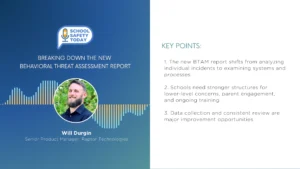How Shared Spectrum Connectivity Benefits Distance Learning
Today’s students, teachers, and administrative staff are facing unprecedented connectivity challenges as the 2020 school year brings more and more distance learning options. School districts’ commitment to the “no child left behind” mission takes on a new meaning with today’s technology and learning formats, as students must now have access to reliable, secure internet service in order to access all their educational opportunities. Such connectivity is now a requirement for all distance learning solutions currently being used, including e-campus portals and learning management solution platforms.
Students who don’t have access to high-quality internet service are at significant disadvantage compared to their connected peers. Furthermore, students who need to visit their school campus or other public facilities in order to obtain access to reliable connectivity risk exposure to COVID-19.
Today, more than 9 million students lack proper access to reliable broadband internet at home, which creates obstacles for both the students and teachers. This, coupled with potential learning disabilities, households with multiple students and parents or guardians with language barriers, creates unprecedented challenges for the industry.
Shared spectrum initiatives as the answer
In January 2020, the FCC authorized commercial use of Citizen Broadband Radio Service (CBRS) connectivity, an initiative that broadly opens the use of the 3.5 GHz spectrum band for shared public and private use. This enables commercial users — e.g. school districts — to leverage a vast amount of invaluable underutilized mid-band spectrum. It provides a cost-effective and high-performance connectivity solution to make uncompromised 4G LTE- and 5G-quality connectivity readily available for education buildings, school campuses and district networks.
As a result, schools and universities across the country are looking to provide a private wireless internet network, to be exclusively used by the school district, via shared spectrum connectivity within the 3.5 GHz CBRS band. By deploying a private LTE network for distance-learning, shared spectrum connectivity can provide students and staff access to a more reliable network from their homes — creating a better and more seamless distance-learning experience.
These private LTE networks can complement both public cellular and existing Wi-Fi networks, as well as provide coverage where neither exist, bringing connectivity to students who live in rural areas. Especially in today’s world where wireless internet access is a utility and a lack of such connectivity can limit students’ access to an education, shared spectrum connectivity is imperative.
Additionally, shared spectrum connectivity can provide fixed wireless solutions to offer the reliable connectivity needed to support video-based learning. By doing so, school districts can deploy local antennas that connect directly to in-home routers using wireless connectivity, as opposed to relying on fiber connections — which are subject to availability, depending on a student’s location.
Addressing today’s concerns with shared spectrum
A shared spectrum approach can provide uncompromised connectivity at a fraction of the cost of traditional LTE by enabling schools to deploy their own private wireless network without the complexities associated with traditional carriers. This makes shared spectrum connectivity a viable investment for schools that have received funding to help cope with the impact of COVID-19. The use of shared spectrum could mean that disadvantaged students such as low-income students, students with disabilities, foster students, homeless students, and English-as-a-second language (ESL) learners won’t lose a school year or won’t be behind track to graduate.
In order to ease remote teaching efforts, some schools have set up classrooms with cameras and personal computers for staff to live-stream lectures. However, this requires reliable, high-speed internet access, with which many campus buildings are not equipped. Shared spectrum connectivity can provide the necessary broadband speeds to support live online lectures, ensuring an uninterrupted and convenient learning environment.
Additionally, virtual safety and cybersecurity have become extremely pressing concerns around online learning and video conferencing platforms — especially for young children. Shared spectrum connectivity can ensure that a school district’s private LTE network remains private, allowing access exclusively to authorized users. Furthermore, the security of such data is ensured since the data remains on-premise, off the internet and SIM-secure.
Shared spectrum for education: Beyond COVID-19
Despite addressing the connectivity challenges associated with distance learning, a fair question when looking to invest in shared spectrum connectivity is, “What are the benefits beyond COVID-19?”
Here are some additional use cases in which schools can reap the benefits of shared spectrum, even after distance learning is no longer in effect:
● Campus transportation tracking: Enabling students and staff to see when and where buses will be arriving.
● Campus security enhancement: Supporting connectivity of campus blue light emergency phones, surveillance security cameras, sensors, campus security communications and access control systems.
● Digital record keeping: Providing a secure private LTE network can help prevent catastrophic security breaches of personal information, as well as enable administrators to more easily track and update student and staff records.
● Extended campus wireless coverage: Enhancing wireless internet connectivity for staff and students campus-wide via high-speed wireless services, eliminating dead zones, such as areas within athletic buildings and dorms, to help keep and attract the best faculty and students.
Take-aways from education’s “new normal”
While the future format of education at all levels remains uncertain, it’s critical that students and staff have access to the resources they need to succeed in learning in and creating an interactive virtual-learning environment.
By providing high-capacity wireless solutions, CBRS shared spectrum enables all students and staff to have access to reliable, secure wireless connectivity. Whether it be virtual circle-time in kindergarten, or virtual lectures in college, CBRS ensures that no student is denied access to a quality (virtual) education or critical education resources.








